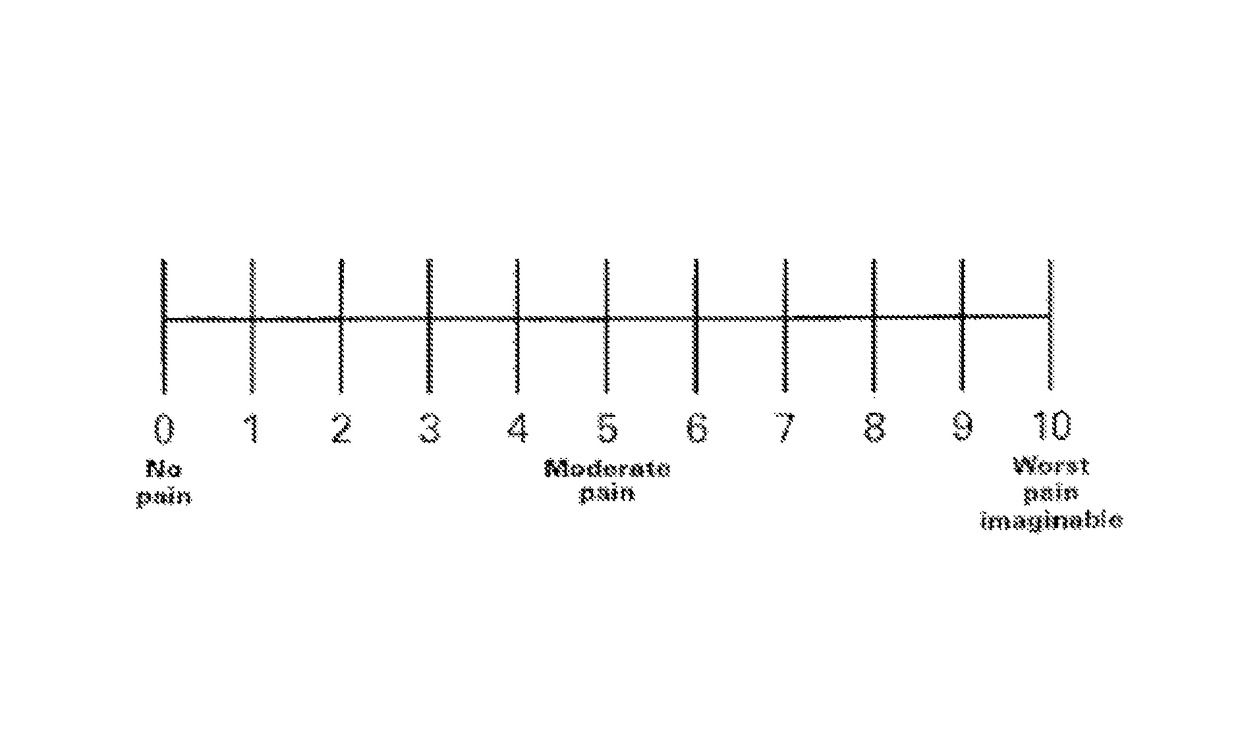Topical compositions for pain relief, manufacture and use
a technology of transient receptor potential and composition, which is applied in the direction of drug composition, heterocyclic compound active ingredients, and aerosol delivery, etc., can solve the problems of unable to achieve long-term effects, and inability to achieve effective pain relief for more than a day or two
- Summary
- Abstract
- Description
- Claims
- Application Information
AI Technical Summary
Benefits of technology
Problems solved by technology
Method used
Image
Examples
example 1
Preparation of 100 Grams of “2% Cap-HA Form 2” Topical Formulation
Ingredients:
[0178]2 grams of Trans-Capsaicin Powder, Aversion Technologies, Bowie, Md., USP 30[0179]0.15 grams of Sodium Hyaluronic Acid Powder, Making Cosmetics Inc., Snoqualmie, Wash.[0180]0.35 grams of Sodium Hyaluronic Acid (SLMW) Powder, Making Cosmetics Inc., Snoqualmie, Wash.[0181]20 grams of Ethyl Alcohol, Graves Grain Alcohol, 190 Proof[0182]10 grams of DGME (Ethoxydiglycol), Lotioncrafter Inc., Eastsound, Wash.[0183]10 grams of Propylene Glycol, Lotioncrafter Inc., Eastsound, Wash.[0184]2 grams of Super-refined Polysorbate 80, Croda Inc. Florham Park, N.J.[0185]5 grams of Cremophor RH 20, BASF Corp, Florham Park, N.J.[0186]q.s. Distilled Water
Step I—Preparation of the Hyaluronic Acid Solution
[0187]1. Obtain the “tare weight” of a 200 cc Pyrex beaker & add 0.15 grams of Sodium Hyaluronic Acid Powder and 0.35 grams of Sodium Hyaluronic Acid (SLMW) Powder.[0188]2. Slowly add cold (˜40° F.) 50 grams of distilled...
example 2
Topical Application of the 0.25% Capsaicin-HA Formulations
[0223]This study assessed the tolerability of four topical capsaicin formulations by recording burning sensations and skin irritation on the right and left thigh of a 59-year old male of normal health. The formulations were applied with a roller-ball applicator.
[0224]
TABLE 4Capsaicin Test FormulationsCapZaicin(1)0.25%(2) 0.25%No-Fuss0.15%CapCap-HAApplicatorIngredientsM / AForm-2Form-2(Walgreens)Capsaicin0.150.250.250.15Methyl Salicylate50———Camphor11———Liquefied Phenol0.5———Ethyl Alcohol23.352020—(Grain alcohol)DGME—1010—Propylene Glycol—1010—(PG)Cremophor RH-40——0.5—Hyaluronic——0.15—Acid ~1,000KDaltonsHyaluronic——0.35—Acid ~20KDaltonsDistilled Water—59.7558.75—Other15%——Carbomer,MentholGlycerin, PG,SD Alcohol(35%), Tri-ethanolamine,WaterNote:(1)Formulation No. 1 in Table 3.(2) Formulation No. 2 in Table 3.
Formulation Application
[0225]Each formulation was applied to an area measuring 25 square centimeters (5×5 cm) of skin locat...
example 3
Topical Application of the 0.25% Capsaicin-HA Formulations
[0241]A group of 2 adult males and 2 adult females of normal health and ranging in ages from 35 to 55 applied multiple topical application of 4 formulations from 3.7 ml roller-ball applicators as noted in TABLE 6. The subjects noted that the 0.25 wt. % HA / capsaicin formulation was the most tolerable in term of the burning and erythema ratings. The average burning and erythema ratings for the 4 subjects are summarized in TABLE 6.
[0242]
TABLE 6Burning & Erythema Post Application MeasurementsFor 4 Topical Capsaicin Formulations(Average of 4 Subjects)After Hot Shower1 minute post20 minutes post40 minutes post2 hours postTestapplicationapplicationapplicationapplicationFormulationsBurningErythemaBurningErythemaBurningErythemaBurningErythema0.15% M / A0.202.501.20.34.71(1)0.25% Cap0.801.60.51.30.54.02.6Form 2(2)0.25% Cap-0.300.60.30.60.52.30.9HA Form 2(3)CAPSAICIN0.601.70.51.31.03.81.30.15%Note:(1)Formulation #1 in Table 3(2)Formulatio...
PUM
| Property | Measurement | Unit |
|---|---|---|
| melting point | aaaaa | aaaaa |
| wt. % | aaaaa | aaaaa |
| particle size | aaaaa | aaaaa |
Abstract
Description
Claims
Application Information
 Login to View More
Login to View More - R&D
- Intellectual Property
- Life Sciences
- Materials
- Tech Scout
- Unparalleled Data Quality
- Higher Quality Content
- 60% Fewer Hallucinations
Browse by: Latest US Patents, China's latest patents, Technical Efficacy Thesaurus, Application Domain, Technology Topic, Popular Technical Reports.
© 2025 PatSnap. All rights reserved.Legal|Privacy policy|Modern Slavery Act Transparency Statement|Sitemap|About US| Contact US: help@patsnap.com



